- Chapter 1Why Is Client Reporting Important?
- Chapter 2Creating a Framework for Client Success
- Chapter 3What Is a KPI?
- Importance of Key Performance Indicators
- Different Kinds of KPIs
- Breaking Down KPIs by Department
- 3 Steps To Develop KPIs for Your Clients’ Business Goals
- Essential Tips for Crafting Client-Focused KPIs
- How To Measure and Report Results Against KPIs
- Drive Results and Build Trust With KPIs and AgencyAnalytics
- Chapter 4The Key Differences Between KPIs vs Metrics
- Chapter 5Top Digital Marketing Metrics to Showcase Success
- Chapter 6What To Include in Client Reports
- Chapter 7Using Data Storytelling in Client Reports
- Chapter 8How To Use Automated Client Reporting To Reclaim Billable Hours
- Chapter 9Advanced Client Reporting Strategies & Best Practices
- Chapter 10Buying vs. Building a Reporting Platform
A Key Performance Indicator (KPI) helps agencies measure the success of their campaigns and adjust strategies to meet client goals. For agency leaders, understanding and effectively utilizing KPIs will transform client relationships and campaign outcomes.
This chapter covers various types of KPIs, explores their critical role in marketing, and provides actionable steps for crafting KPIs aligned with client objectives and success.
Whether you're new to performance metrics or looking to refine your approach, you’ll find essential insights and practical advice to enhance your decision-making and drive better results. Get ready to unlock the full potential of KPIs and elevate your agency's performance.
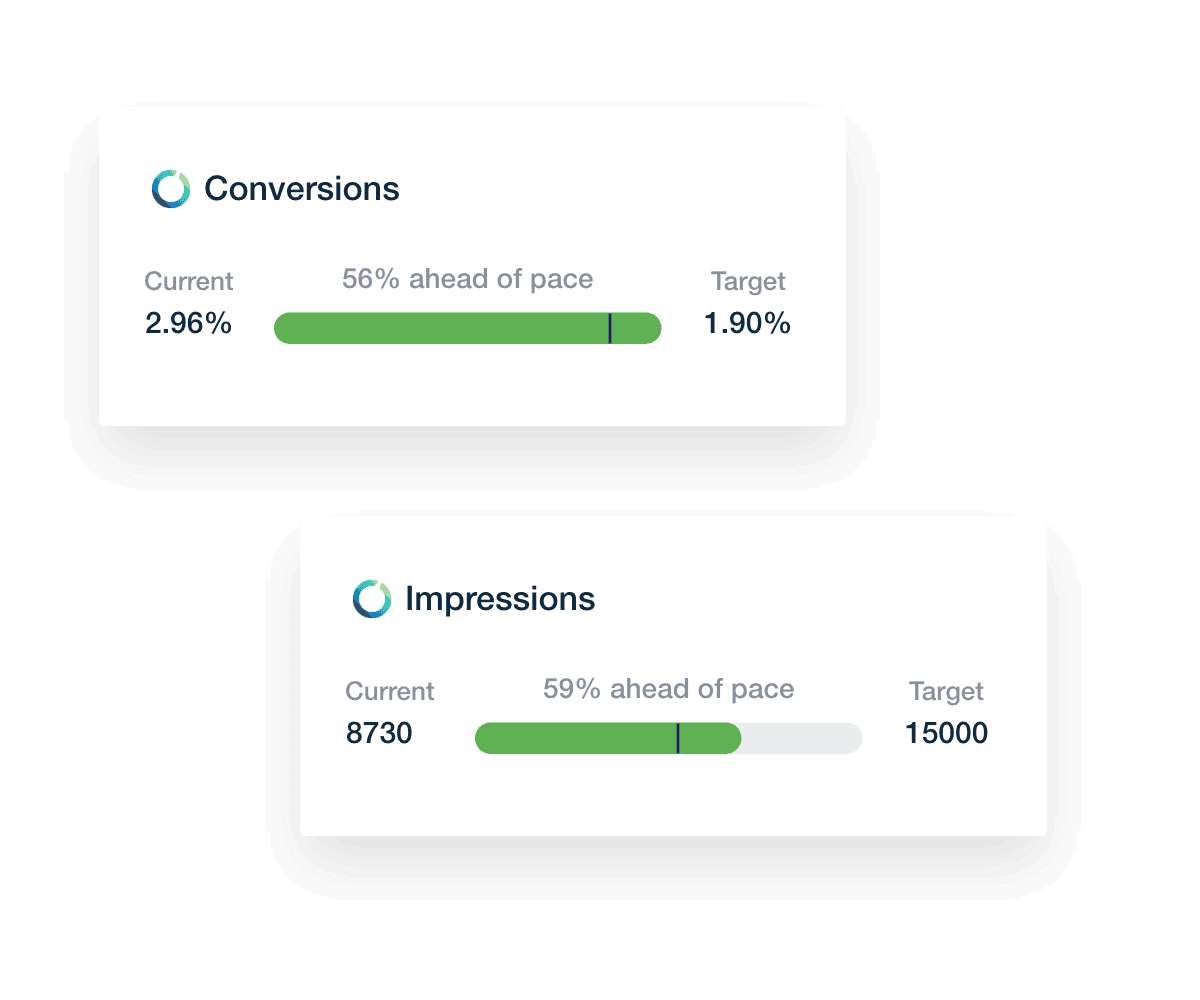
Understanding the meaning of KPI in marketing terminology is essential to distinguishing it from a simple metric. KPIs focus on strategic objectives and directly impact organizational success, whereas metrics provide detailed insights into specific business operations.
Choosing the right KPIs is essential for any organization looking to improve performance. However, simply selecting KPIs is not enough; they must also be tracked and analyzed regularly to identify trends and take corrective action. By using KPIs, companies improve their performance and achieve their goals.
Not everything that can be counted counts, and not everything that counts can be counted.
Albert Einstein
Think of KPIs as key metrics directly related to business objectives. These could be revenue growth, user acquisition, or other metrics, but the critical point is that each KPI is tied to a specific goal.
Some relevant KPI examples that clients often want to look at include:
New client acquisitions per month
Cost per acquisition
Client retention rates
New leads from organic vs. paid search
Page domain/authority
Monthly website traffic
Here are some examples of the most common KPIs based on business types:
Professional Service KPIs | SaaS KPIs | Retail KPIs | Online Media / Publishing KPIs | Ecommerce KPIs |
Bookings | Capital Expenditure | Unique Visitors | Users | |
Utilization | Customer Satisfaction | Page Views | Conversion Rate | |
Backlog | Sales Per Square Foot | Share Ratio | Cart Abandonment Rate | |
Revenue Leakage | Average Customer Spend | Social Referral Growth | Cost Per Acquisition | |
Effective Billable Rate | Stock Turnover | Time on Site | AOV (Average Order Value) | |
Revenue Per Employee | Shrinkage | E-Newsletter Signups | Profit |
As you can see, KPIs vary based on the business model and industry, although they all directly impact a specific business objective.
Importance of Key Performance Indicators
KPIs are essential for effectively managing and optimizing marketing campaigns. They provide clear metrics that guide agencies in evaluating their performance and strategizing for growth.
KPIs act as the litmus test for the effectiveness of marketing initiatives. By providing measurable data on various aspects of a campaign, they help agencies pinpoint what’s working and what’s not.
With clear KPIs, agencies and clients ensure that all marketing efforts are strategically aligned with desired outcomes. KPIs focus efforts on targeted goals, eliminating wasteful practices and optimizing resources.
Benefits of Using KPIs:
Accountability: KPIs create a framework of accountability within the agency. Each team member understands their specific contributions toward campaign goals, fostering a sense of responsibility and commitment to success.
Goal Alignment: They align the agency’s tactical efforts with the client’s strategic objectives. This congruence is essential for building trust and satisfaction, key components of successful long-term relationships.
Performance Tracking: By regularly and systematically tracking KPIs, agencies provide clients with detailed and transparent performance reports. These reports demonstrate campaign success and help make informed decisions and real-time adjustments to enhance effectiveness.
KPIs are indispensable tools for strategic decision-making, providing a foundation for strong client relationships and sustainable business growth. By effectively implementing and managing KPIs, marketing agencies ensure their strategies are data-driven, client-focused, and aligned with achieving tangible results.
Different Kinds of KPIs
KPIs (Key Performance Indicators) can be categorized into several types, each serving a specific function in measuring and guiding the success of marketing activities. These distinctions help agencies tailor their monitoring and reporting to align with strategic goals.
Understanding KPI meaning helps differentiate between general metrics and key performance indicators, which are crucial for strategic planning and goal achievement.
Quantitative vs. Qualitative KPIs:
Quantitative KPIs are measurable and expressed in using objective data, like click-through rates or sales figures.
Qualitative KPIs focus on subjective measures, such as brand sentiment or customer satisfaction, typically gathered through surveys or feedback.
Leading vs. Lagging Indicators:
Leading indicators predict future outcomes, such as lead generation stats forecasting sales growth.
Lagging indicators reflect past outcomes, like post-campaign revenue figures, to assess the effectiveness of past activities.
Leading and lagging indicators offer valuable insights into a marketing strategy's journey. The former predicts future performance, while the latter reflects past outcomes. The key to successful marketing lies in balancing the insights from both types of indicators.
Marketing KPI | Leading Indicator Examples | Lagging Indicator Examples |
Number of new, unique website visits | Total website traffic over a given period | |
Social Media Engagement | Likes, shares, comments, and mentions on social posts | Increase or decrease in followers or subscribers over time |
Number of emails opened immediately after a campaign launch | Overall open rate of an email campaign | |
Early clicks on a newly published ad | CTR after the ad campaign has ended | |
Increase in completed website forms or sign-ups | Total conversions achieved at the end of the campaign | |
Current marketing spend | CAC after the campaign, calculated as total campaign spend divided by the number of new customers | |
Estimated ROI based on projected sales from leads | Actual ROI after campaign costs and revenue are calculated | |
Early repeat purchases from new customers | CLV is calculated after the customer has ended their relationship with the company | |
Net Profit Margin | Initial revenue and cost estimations for a project | Actual net profit margin after all expenses and revenues are finalized |
Early survey responses following a new product release or service change | NPS after the survey period ends | |
Ecommerce Sales | Number of added-to-cart items | Total sales at the end of a specified period |
Initial click-throughs and conversions on new Google Ads | ROAS after the ad spend and revenue are calculated, which an also inform the customer acquisition cost. | |
Lead Generation | Number of form views for a downloadable resource | Total leads generated after the campaign |
Input, Process, and Output KPIs:
Input KPIs measure resources used in a campaign, like budget spent.
Process KPIs evaluate the efficiency of a process, such as the average time spent creating content.
Output KPIs measure the results of a campaign, like total units sold.
Vanity KPIs
These metrics look impressive but don’t necessarily correlate with business success, such as the number of social media followers, so they don't always make for a good KPI. It's critical to distinguish these from strategic KPIs directly impacting business goals.
By categorizing KPIs and understanding their specific uses, agencies more effectively measure what matters and avoid focusing on metrics that don’t drive meaningful outcomes.
Breaking Down KPIs by Department
Each department has a unique role in any organization, guided by strategic goals and measured by carefully selected KPIs and metrics.
Whether a sales team is hungry for revenue growth or a marketing team is itching for brand visibility, KPI dashboards become the compass. A KPI dashboard (or a KPI report template) provides the much-needed direction to track progress and steer towards success.
Let’s look at key departments and their associated KPIs.
Sales KPIs
The sales team are the adrenaline junkies of the corporate world. Always on the hunt, chasing targets and bringing in the dough. KPIs help measure progress and ensure everyone’s sprinting in the right direction.
Using professional sales reporting software to generate metrics like the lead-to-conversion ratio provides deeper insights and improves sales performance.
Key sales KPIs include:
Revenue Growth: The change in a company’s sales compared to a previous period.
Gross Profit Margin: This tells how well sales cover direct costs and sheds light on operational improvement.
Net Profit Margin: This financial metric provides insights into the company’s overall profitability after all expenses.
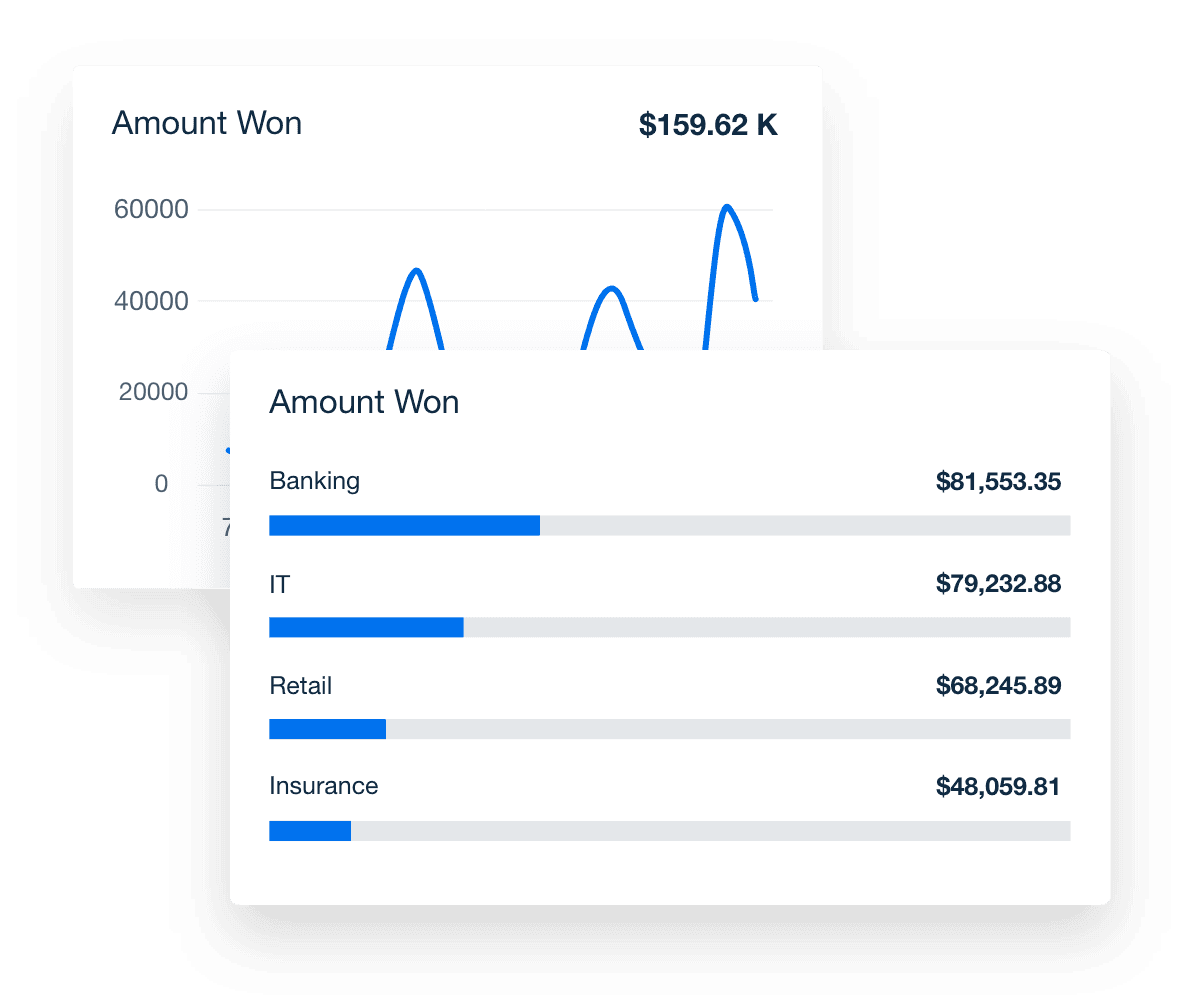
Marketing KPIs
If the sales team are adrenaline junkies, the marketing teams are the maestros, conducting the orchestra to produce a symphony of brand engagement. When you accurately measure KPIs, it helps the team monitor progress and ensure the melody hits all the right notes.
Some common marketing KPIs include:
Social Media Engagement: This social media KPI measures the interactions on your social media channels.
Email Open Rate: This shows the percentage of recipients who open a given email.
Return on Marketing Investment (ROMI): This provides performance data on the effectiveness of marketing campaigns.
Budget Pacing and Spend: To make sure client budgets are on track.
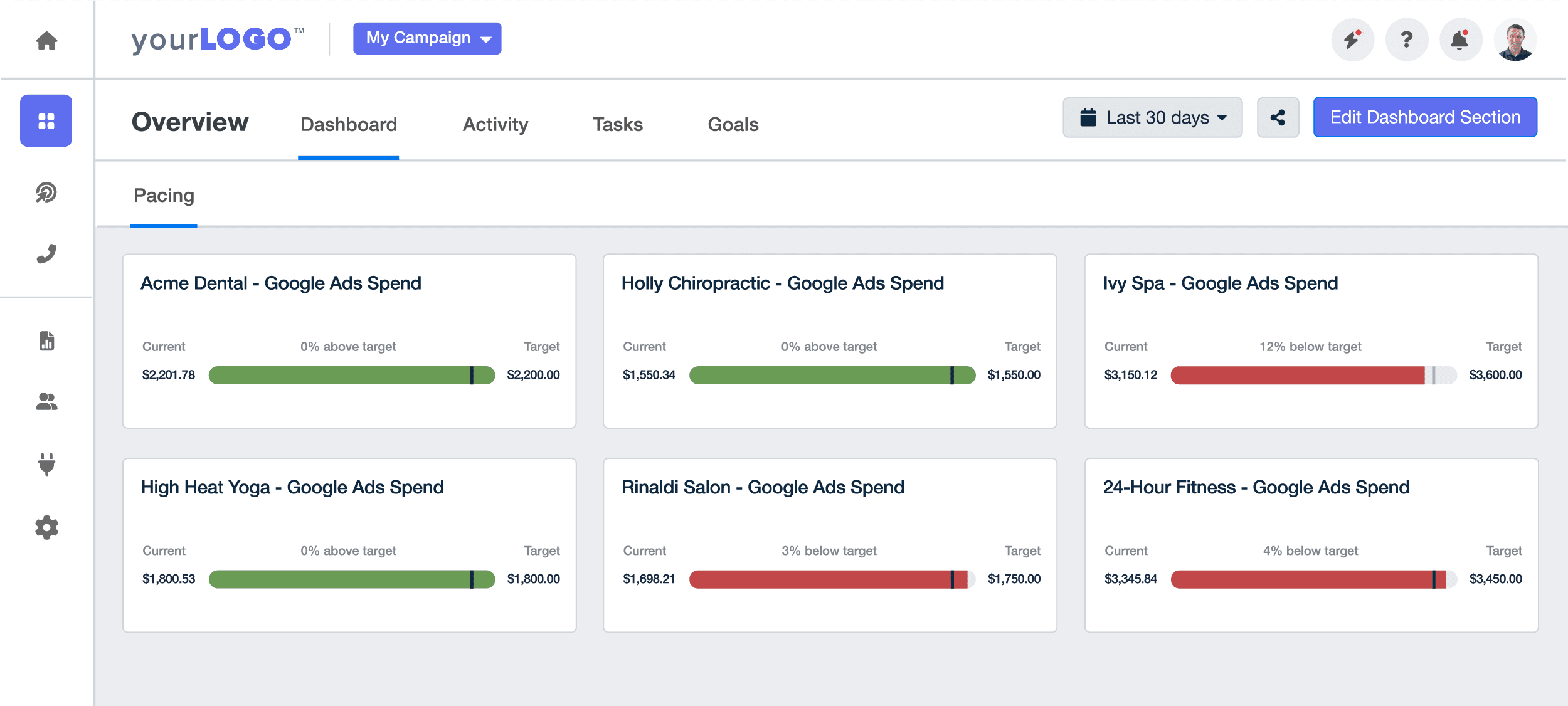
Financial KPIs
The finance team is the gatekeeper. They monitor financial metrics, balance risk factors, and drive profitability.
Relevant KPIs for finance often include:
Operating Cash Flow: This KPI checks if a company's core operations generate sufficient cash to maintain and grow the business.
Current Ratio: This assesses the ability to cover short-term liabilities with short-term assets.
Quick Ratio: This is a more conservative measure than the current ratio, excluding inventory from assets.
Revenue Churn: An important financial KPI that drives customer lifetime value and overall financial health.
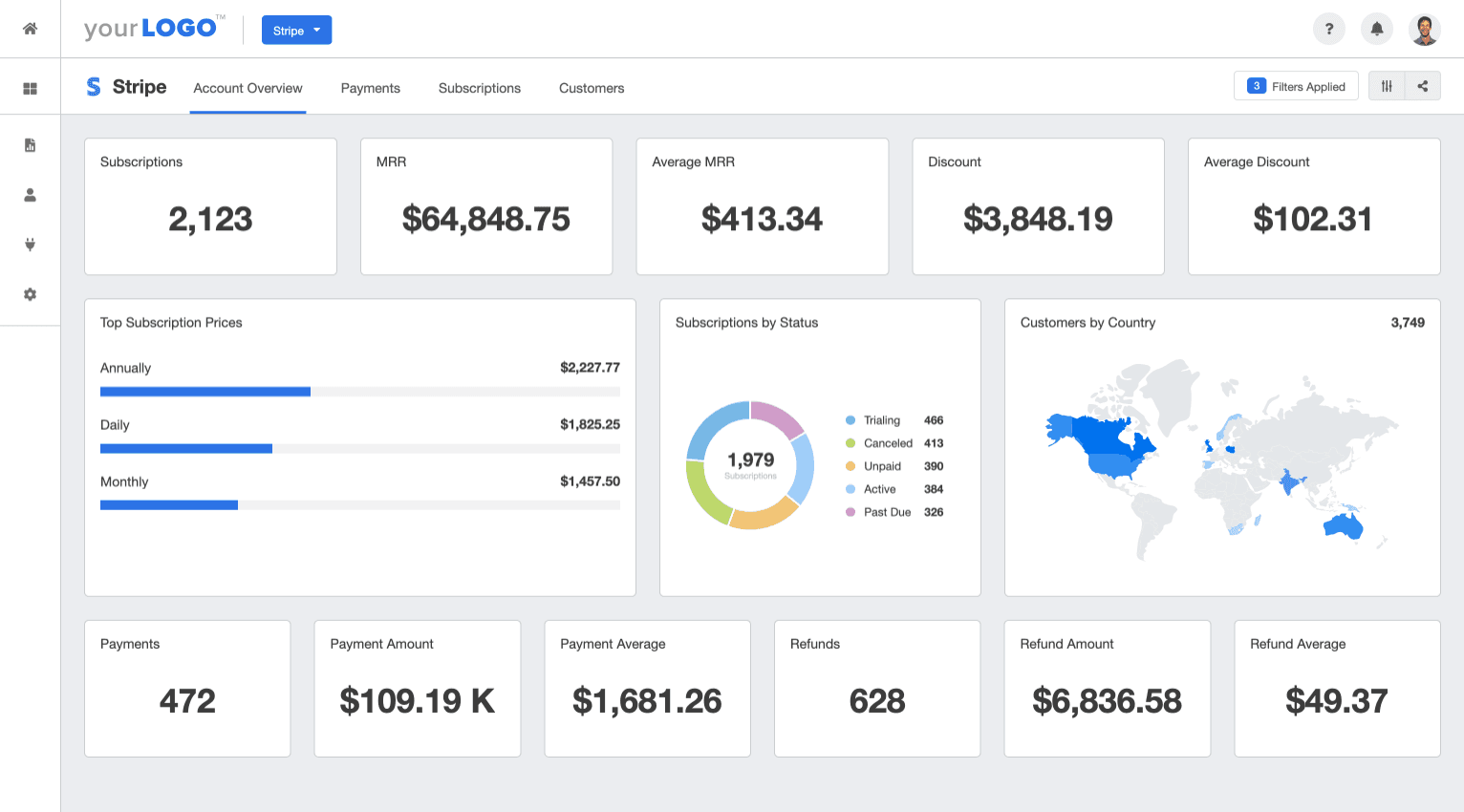
Customer Satisfaction KPIs
Customer Success teams are the superheroes of the corporate world. They save the day by ensuring customer retention and satisfaction.
Their customer service KPIs often revolve around:
Customer Satisfaction Scores (CSAT): This measures how satisfied customers are with your service.
Net Promoter Score (NPS): This gauges the loyalty of a firm's customer relationships.
Customer Retention Rate: This tracks how well a company retains customers over a given period.

There are also several other business metrics that will become KPIs if that metric is key (pun intended) to the business growth. These can include anything from overall financial performance to employee turnover rate.
Just remember, KPIs are a guide, not a destination. Business success is a continuous trek of learning and adapting.
When establishing KPIs, it’s important to remember they all need to feed a central business objective. For example:
Business Objective | Sales KPIs | Marketing KPIs | Finance KPIs | Customer Success KPIs |
Total Revenue | New Closed Deal Revenue, Opportunity Pipeline | Revenue by Channel, Average Order Value | Net Revenue, Operating Cash Flow | Customer Lifetime Value (CLV), Upsell and Cross-Sell Rate |
Total Customers | Number of Deals Closed, Outbound Lead Acquisition Rate | Customer Profitability Score, Current Ratio | Customer Satisfaction Score (CSAT), Customer Retention Rate | |
Net Profit | Revenue Per Rep, Sales Growth Rate | Net Income Margin, Debt to Equity Ratio | Customer Churn Rate, Average Revenue Per Customer |
3 Steps To Develop KPIs for Your Clients’ Business Goals
Here is a three-step process to help you identify which KPIs to use for your clients’ businesses:
Step 1: Pick One Main Business Goal for the Year
Business owners usually discuss strategic objectives and business goals when discussing KPIs. Regardless of the goal, the first step is clearly understanding what the client wants to achieve.
We start with a template for our new clients, and during their onboarding, we ask what their top KPIs are. We make sure to include those on the first page for them.
As we have our first few strategy meetings, we take a look at these reports and ask our clients about their reports, and make edits to the templates with our clients as another customization tool.
Christina Cypher, Director of Marketing, Click Control Marketing
Of course, your client's goals will depend on their situation, but here are a few helpful questions to ask them:
Is the business already profitable? Set a revenue goal.
Does the business barely break even? Set a profitability goal.
Are they working with a venture-funded startup you are helping turn into a $1 billion valuation? Set a user growth rate goal.
Step 2: Identify Which KPIs Have a Direct Impact on Your Clients’ Business Goals
Now that you understand your client’s set business goals for the year, it’s time to examine all the important metrics currently being tracked in their business.
All these metrics are at least somewhat relevant to the company's performance. Still, the reality is that most of them are likely not directly related to their primary business objective. While you still want to watch them, these metrics don’t necessarily qualify for your relevant Key Performance Indicators.
Metrics are only useful if they help to drive decision-making. As a result, we focus on identifying actionable metrics that can be used to inform and improve our marketing efforts. To do this, we start by closely examining our goals and objectives.
We then identify the key performance indicators (KPIs) to help us measure progress towards those goals.
Guy Hudson, Founder, Bespoke Marketing Plans
In this step, you need to ask yourself which metrics are the most valuable when evaluating the progress toward the overarching goal.
The KPIs that matter most are the relevant metrics aligned with your goal, which provide the clearest indication of progress. For example, if you set an annual revenue goal, the most valuable KPI will be daily, weekly, monthly, and quarterly. And typically, the longer the period, the more important it is. For example, quarters matter more than months, which matter more than weeks.
The number of KPIs to choose will vary from client to client and the industry they’re in. However, they often increase as you drill into each campaign your agency manages. For example, your paid search team could have three KPIs (cost, revenue, and cost of acquisition), and your SEO team could have its own KPIs (organic traffic, conversion rate, and revenue).
Step 3: Create a Schedule for Reviewing KPIs To Ensure That You’re Progressing Towards Client Goals
Once you and your client have identified the KPIs to focus on, you’ll want to review them regularly. It’s best to review your KPIs at four intervals: weekly, monthly, quarterly, and annually.
AgencyAnalytics makes it easy for us to share campaign performance with our clients on a weekly and monthly cadence.
We normally create a dashboard that features the primary KPIs for each channel we are managing on behalf of our clients and we share client access with them.
They love that they are able to dive deep into the analytics on their own without needing our input each time.
Bryan Lozano, Vice President of Operations, Ad-Apt
This shows that your agency stays on top of its goals, helps identify any issues as they arise, and makes proactive adjustments or recommendations to correct them. Talk about showing agency value!
Essential Tips for Crafting Client-Focused KPIs
You want to develop effective KPIs closely aligned with objectives that ensure marketing efforts directly contribute to client goals. Here are detailed steps to help agencies create effective, client-focused KPIs:
Identify Client Objectives: The first critical step is understanding the client’s business goals. Engage with the client to define clear objectives, whether they're aiming to increase sales, enhance brand recognition, or improve customer loyalty. This deep understanding will direct the choice of KPIs.
Select the Right Success Metrics: Based on the identified objectives, choose KPIs that serve as accurate indicators of success. For instance, if the target is increased sales, the right key performance indicators might include lead conversion rates and average order value. Meanwhile, KPIs like customer retention rates and Net Promoter Scores should be considered to measure customer loyalty.
Set Benchmarks and Targets: Analyze past performance data and industry benchmarks to determine realistic yet challenging targets for each KPI. This could involve quantitative goals, such as a 20% increase in lead generation, or qualitative benchmarks, such as improving customer service department response times.
Write and Share the KPIs: Formulate a clear, detailed plan articulating each KPI, its rationale, and the measurement method. Share this plan with the client to ensure transparency and alignment. Ensure they fully understand what each KPI means and how it relates to their business objectives.
Track Progress: Implement tools and systems to monitor these KPIs continuously. Digital dashboards and reporting tools can provide the agency and the client with real-time insights into performance. This ongoing tracking enables swift identification of trends and potential issues.
Ongoing Communication With Clients: Maintain a regular dialogue with the client about KPI performance. Schedule periodic reviews to discuss the results, interpret the data, and make informed decisions on necessary strategic adjustments. This ongoing communication fosters a collaborative relationship and keeps the client engaged and informed about the campaign’s progress.
Why You Should Never Use a Single KPI To Measure Performance
Relying on a single KPI for your clients’ businesses is an extremely narrow approach. It doesn’t leave any flexibility for areas of improvement, and it leads to many other potential risks, including:
The wrong measurement may steer clients in the wrong direction. For example, focusing exclusively on leads as an ecommerce KPI could tell a misleading data story if none of those leads convert to paying customers.
A single KPI fails to paint a complete picture of performance. Perhaps revenue targets were missed that month, but the sales pipeline is chock full of opportunities that will close a couple of weeks down the line. Looking at a complete picture is always beneficial before making business decisions.
Any metric taken in isolation is a vanity metric. To really understand performance, you need to analyze a range of KPIs together. Traffic is no good unless you understand what keywords drive that traffic and whether they generate conversions or sales.
Paul Morris, Managing Director, Superb Digital
How To Measure and Report Results Against KPIs
Measuring and reporting KPIs effectively is crucial for demonstrating campaign success and guiding future marketing strategies. Here’s how to ensure your KPI performance measurement and reporting are both accurate and impactful:
Regular Data Collection: Ensure continuous and consistent data collection to maintain the integrity of your KPI tracking. Leverage automated data aggregation tools that pull performance data across various platforms.
Use Relevant Tools: Use analytics tools that align with your specific KPIs. For example, use social media analytics platforms to track engagement metrics or Google Analytics to track website traffic and conversion rates.
Data Verification: Routinely check the data for accuracy and anomalies. Validating your data prevents reporting on skewed information, which can lead to misguided decisions.
Contextual Analysis: Analyze KPI data within the context of external and internal factors. Understanding the broader context helps accurately interpret KPIs fluctuations, such as seasonal variations or market changes.
Use AgencyAnalytics for Optimal KPI Reporting
AgencyAnalytics offers an all-in-one solution that helps marketing agencies efficiently manage and report on key performance indicators. The platform features customizable digital dashboards that provide real-time updates on essential metrics tailored to each client’s needs. Agencies and clients get a complete view and assess the most relevant data quickly, facilitating faster decision-making and strategy adjustments.
With robust visualization options like charts, graphs, goals, and annotations, AgencyAnalytics makes complex data straightforward and easy for clients to understand. It also allows for segmented reporting, allowing agencies to dissect data by demographics, channels, or specific campaigns for deeper analysis and more targeted strategy development.
With AgencyAnalytics, agencies streamline their reporting process and generate and distribute reports automatically—whether daily, weekly, or monthly—saving time and ensuring consistent, error-free updates for clients.
Examples of AgencyAnalytics KPI Dashboards
Digital Marketing Dashboard: Displays all critical metrics such as click-through rates, conversion rates, and ROI, giving a comprehensive view of campaign performance.

SEO Dashboard: Tracks rankings, keyword performance, and backlink quality to gauge the effectiveness of SEO strategies.
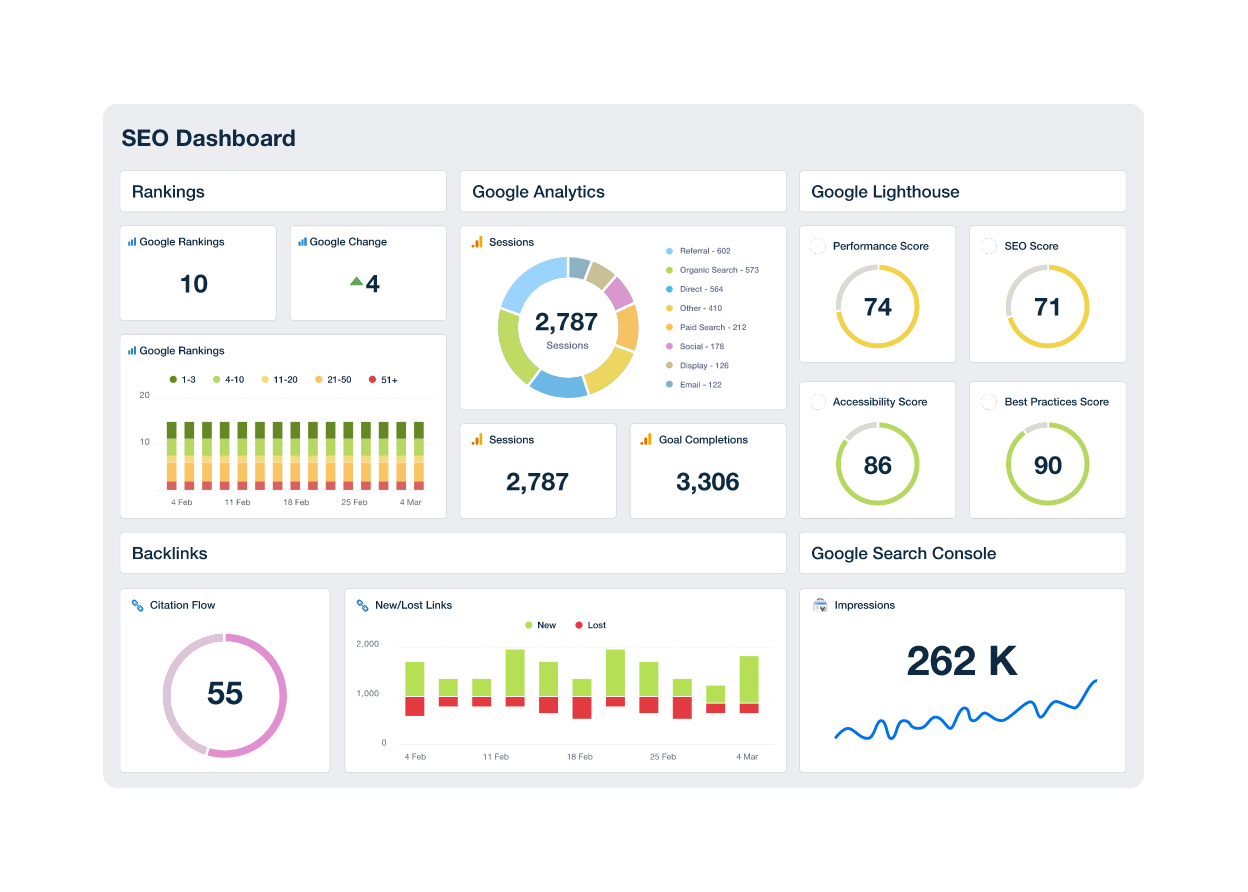
Social Media Dashboard: Offers detailed reports on engagement, follower growth, and content performance across various social platforms.
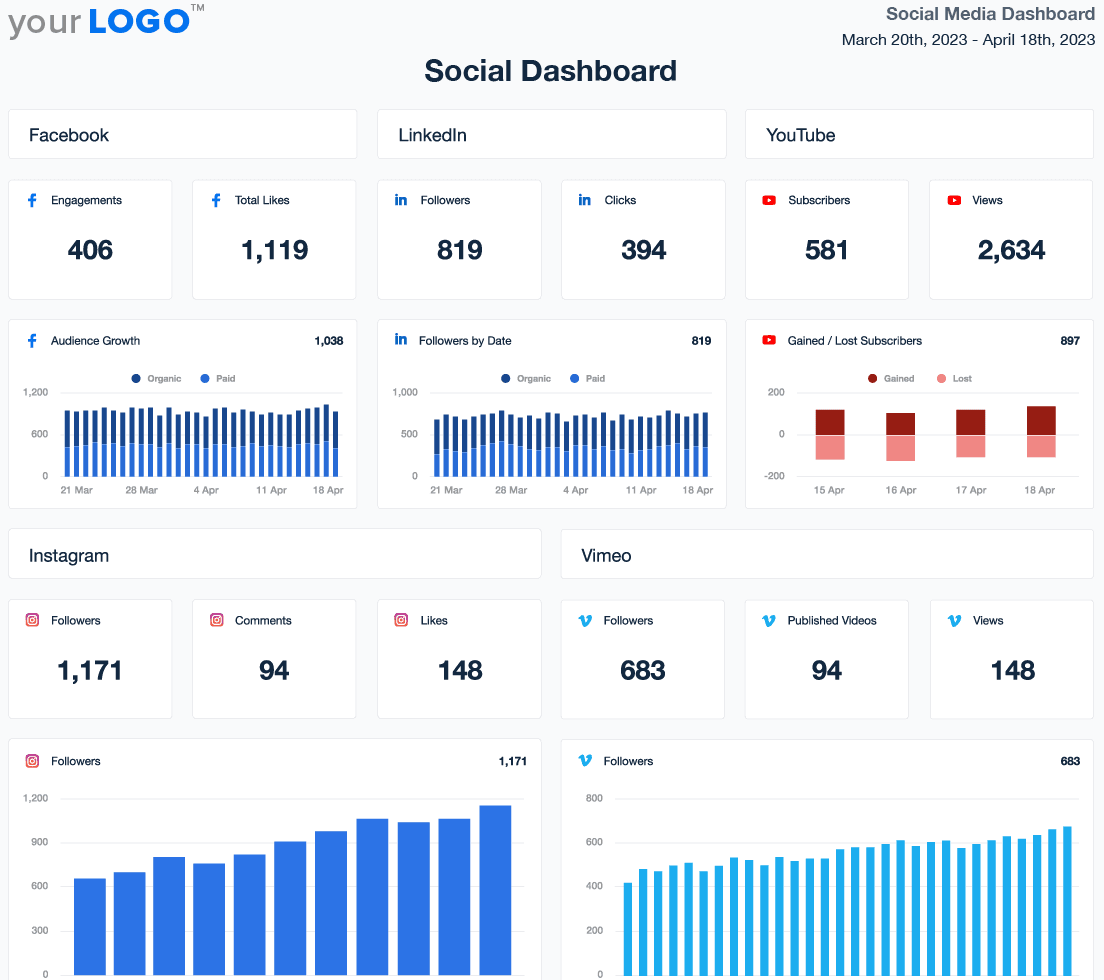
Ecommerce Analytics Dashboard: Allows for the creation of customized reports that include branding and specific insights tailored to each client’s needs, fostering better communication and alignment on performance goals.

Effectively measuring and reporting KPIs is about more than just numbers; it involves strategic presentation and insightful analysis to ensure that KPIs drive decision-making and client satisfaction.
By following these best practices and leveraging AgencyAnalytics dashboards, agencies provide KPI reports with valuable, actionable insights that underscore their strategic value to clients.
Drive Results and Build Trust With KPIs and AgencyAnalytics
Key Performance Indicators (KPIs) are essential for marketing agencies. They provide measurable insights that drive campaign success and align closely with client goals. Effectively using KPIs ensures accountability, enhances strategic alignment, and improves performance tracking, helping agencies demonstrate their value to clients and foster growth for both parties.
AgencyAnalytics offers a powerful solution for managing and reporting KPIs tailored specifically for marketing agencies. With its customizable dashboards, precise visualizations, and automated reporting features, AgencyAnalytics efficiently tracks your clients’ KPIs and assists you in optimizing campaigns based on real-time data.
Start using AgencyAnalytics for free today to turn your data into actionable insights and strengthen your client relationships through proven results.
See how 7,000+ marketing agencies help clients win
Free 14-day trial. No credit card required.

